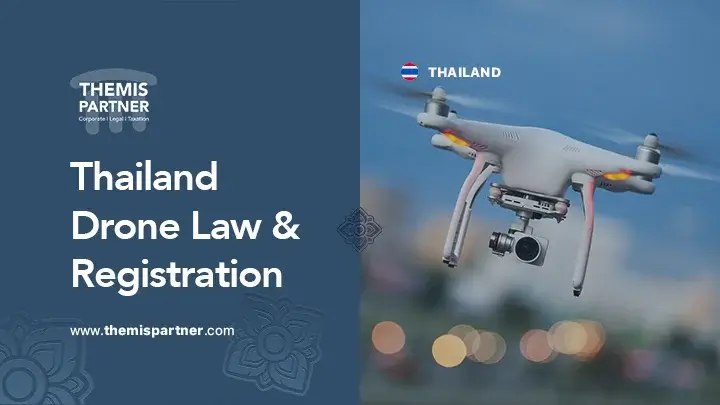Flying a drone in Thailand comes with evolving rules: unregistered drones can now incur fines up to 100,000 THB and inspections are more frequent during peak travel seasons.
Are you confident your drone meets every local rule before takeoff? Thai authorities require all drones with cameras to be registered under both NBTC and CAAT regulations, with liability insurance now strictly enforced for every operator.

Understanding these new requirements, from quick online registration and flight plan submission to privacy best practices is the key to flying worry-free.
This guide gives you the practical insights you need for legal, hassle-free drone operations across Thailand.
Key Takeaways
- Register every drone with a camera through both NBTC and CAAT within 30 days of arrival or local purchase to ensure immediate legal compliance in Thailand.
- Secure liability insurance with a minimum 1 million THB coverage from a CAAT-approved provider before registering; policies must be in English or Thai to avoid delays.
- Carry complete documentation at all times including NBTC registration, CAAT pilot license, and proof of insurance to streamline police spot checks and prevent enforcement issues.
- File a flight plan at least three days in advance via the CAAT UAS Portal and notify local police before each flight to comply with 2025 operating rules and avoid penalties.
- Respect strict drone operation limits: fly below 90 meters, maintain 30 meters from people and structures, and always keep visual contact with your drone.
- Never record private property or individuals without clear consent to align with Thailand’s robust privacy and data protection laws and prevent civil penalties.
- Unregistered drone operation risks severe fines up to 100,000 THB or prison terms of up to 5 years; enforcement has increased, especially near airports and tourist sites.
- Commercial operators must file flight plans for every project, retain extra permits when needed, and keep detailed flight logs to demonstrate full legal compliance and support business continuity.
Table of Contents
Drone Registration in Thailand
Thailand Drone Laws 2025
Drone Penalties & Enforcement
Drone Insurance & Liability
Commercial Drone Operations
FAQ: Drone Rules in Thailand
Conclusion
Drone Registration in Thailand
How to Register with NBTC: Steps & Documents
NBTC registration is required for all drones with cameras in Thailand to comply with radio frequency regulations.
Anyone flying a drone, whether tourist, expat, or resident must register within 30 days of arrival or local purchase.
Prepare these essential documents:
- Passport with entry stamp
- Proof of address (hotel confirmation is accepted for visitors)
- Photographs of the drone, showing model and serial number
- Completed device registration form
Visit the official NBTC portal: anyregis.nbtc.go.th for the latest process and guidance.
CAAT Registration: Insurance & Test Requirements
The CAAT grants flight authorization and operator licensing after NBTC registration.
Follow these steps:
- Arrive in Thailand and obtain a Thai SIM card
- Register at uasportal.caat.or.th
- Upload: passport copy, entry stamp, drone photos, proof of ownership, valid liability insurance (minimum 1 million THB) and pass a 40-question online test
Insurance must comply with Thai standards; issues with foreign policies often delay CAAT approval. Your license is valid for two years, carry both registrations and proof of insurance during every flight.
Remember: Every drone operator in Thailand must complete both NBTC and CAAT steps before takeoff, with prompt attention to detail ensuring stress-free flying and full legal compliance.
Thailand Drone Laws 2025
Flight Rules, No-Fly Zones & Plans
When flying a drone in Thailand in 2025, the most crucial rules include strict compliance with new operational limits and notification protocols.
Operators must follow these regulations to stay compliant:
- Maximum altitude: 90 meters above ground level
- Minimum safe distance: 30 meters from people, vehicles, and buildings
- Visual line of sight: Maintain direct view of your drone at all times
- No flying over crowds, public gatherings, airports, or security-restricted areas
- Flight plan submission required at least three days in advance via the CAAT UAS Portal
- Notify local police at antidrone.police@gmail.com before each flight
Use CAAT’s official map and restriction updates before launching to avoid accidental violations.
Privacy & Data Protection for Drones
Thailand’s privacy laws prohibit recording individuals or private property without clear consent, regardless of drone size or purpose.
Best practices for protecting privacy while operating a drone:
- Always get written or on-camera consent before photography or videography on private premises
- Avoid flight paths over homes, resorts, or sensitive sites
- Never share images of people online without permission
Stay alert: Unintentional data breaches can lead to civil penalties and drone confiscation.
Respect for privacy is as essential as flight safety. Before each flight, ensure both your drone’s path and your camera’s focus align with the law and ethical responsibility.
In summary, staying compliant with 2025’s Thailand drone laws means registering, notifying authorities, keeping flight logs, and putting privacy at the core of your operations.
Drone Penalties & Enforcement
Fines, Jail, and Risks for Illegal Use
Flying a drone in Thailand without meeting legal requirements exposes both professionals and hobbyists to substantial penalties.
Key offenses and penalties include:
- Unregistered drone (NBTC): up to 5 years in prison and/or a 100,000 THB fine
- Unregistered drone (CAAT): up to 1 year in prison and/or a 40,000 THB fine
- Unauthorized flights in restricted zones: immediate drone confiscation and further charges
- Lapses in mandatory drone insurance: additional fines and grounding orders
Recent enforcement includes the confiscation of unregistered drones at airports and popular tourist sites. Regional differences exist, but authorities conduct random spot checks in Bangkok, Chiang Mai, and coastal areas. Enforcement trends indicate increased inspections during festivals and public events.
Spot Checks, Inspections & Police Protocols
If approached by police or officials while flying, stay calm and present your documentation immediately.
Always carry:
- NBTC registration certificate
- CAAT pilot license
- Current insurance policy
Show all paperwork upon request to accelerate the process and demonstrate compliance.
Drone Insurance & Liability
Why Liability Insurance Is Required
Liability insurance is a legal requirement for flying a drone in Thailand: Registration and Legal Rules set a minimum coverage of 1 million THB for every operator.
This insurance protects against property damage or injury caused by drone operation.
To comply, drone owners must:
- Choose a provider approved by the Civil Aviation Authority of Thailand (CAAT), such as leading Thai insurers or specialist international firms
- Select a policy with at least 1 million THB coverage per claim
- Double-check that the insurer issues documents in English or Thai, as required by CAAT
Policies that fail to meet these particulars may be rejected, delaying your ability to fly.
Proof of Insurance & Handling Claims
To register and operate a drone legally, you must be ready to show the following on demand:
- Your policy certificate listing coverage amounts and CAAT reference
- Proof of payment, often requested at checkpoints or during spot checks
- Copies in both digital and hard copy formats
If an incident occurs:
- Notify CAAT immediately through their official channels
- Contact your insurance provider and submit all supporting documents
- Retain incident photos, logs, and communications for your records
Liability coverage is mandatory, but choosing the right policy and keeping documentation organized reduces risk and supports a smooth flying experience across Thailand.
Commercial Drone Operations
Legal Requirements for Business Use
Flying a drone commercially in Thailand requires full compliance with both NBTC and CAAT, plus extra steps for business activities.
Commercial operators must:
- Register each drone with both NBTC and CAAT
- Obtain and maintain at least 1 million THB liability insurance
- Pass the CAAT mandatory online test and obtain pilot licensing
- File flight plans in advance for every job, including exact locations and times
- Retain all approvals, licenses, and insurance on hand during flight
For certain projects, you may need:
- Written consent from property owners or local authorities
- Special flight permits for restricted zones or large events
Business use also requires verification with the Thailand Business Government Portal for industry-specific approvals or processes.
Advanced Compliance Tips for Professionals
Maintain robust business records to protect your organization.
Best practice checklist includes:
- Keeping comprehensive logs for every flight (date, location, client, compliance documents)
- Reviewing insurance policies every year or before new projects
- Drafting clear contracts with clients specifying legal, data, and privacy terms
- Reporting large or sensitive flights to authorities in writing
- Establishing internal SOPs: standard reporting forms and periodic compliance reviews
Staying proactive reduces the risk of regulatory issues and demonstrates your commitment to legal compliance.
Commercial drone operators should build habits and systems around documenting flights and compliance at every step.
FAQ: Drone Rules in Thailand
Do I need to register a drone for one-time or recreational use?
Registration is required for any drone with a camera, regardless of frequency of use or whether you are a tourist, hobbyist, or planning a single flight.
Both NBTC (for device use) and CAAT (for flight authorization) mandate this step within 30 days of entering Thailand or purchasing a drone locally.
Which drones must be registered, and are there exceptions?
- Registration is mandatory for drones equipped with a camera, regardless of weight.
- Drones without cameras under 2kg may be exempt, but 2025 rules recommend verifying status before flight.
- Rules change frequently: always confirm your model’s requirements via CAAT updates (official CAAT link).
How long does CAAT registration take, and can I fly while waiting?
- Processing can range from several days to a few weeks.
- You may not operate your drone until formal CAAT approval and licensing are complete.
- Carry proof of application, but wait for authorization before first flight.
What if my CAAT insurance is rejected, and how can I fix it?
- Review CAAT’s insurance guidelines and ensure your policy meets the 1-million THB minimum coverage.
- Submit a revised or Thai-based policy if your initial application is denied.
- Direct appeals to uasportal.caat.or.th or CAAT support for specific guidance.
Registering early and preparing correct documents are the fastest ways to avoid delays or legal complications when flying a drone in Thailand.
Conclusion
Flying your drone in Thailand offers incredible opportunities. Secure your flight by promptly registering your drone, obtaining the correct insurance, confirming all documentation and planning every flight with safety and compliance in mind.
If you’d like clarity or expert support at any step, from registration to insurance or commercial permits, contact us. Themis Partner streamlines the process so you can focus on flying, not paperwork.
